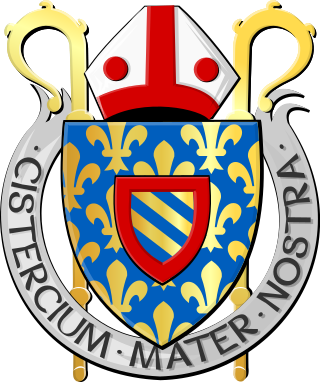
The Cistercians, officially the Order of Cistercians, are a Catholic religious order of monks and nuns that branched off from the Benedictines and follow the Rule of Saint Benedict, as well as the contributions of the highly-influential Bernard of Clairvaux, known as the Latin Rule. They are also known as Bernardines, after Saint Bernard himself, or as White Monks, in reference to the colour of the "cuculla" or cowl worn by the Cistercians over their habits, as opposed to the black cowl worn by Benedictines.

The dissolution of the monasteries, occasionally referred to as the suppression of the monasteries, was the set of administrative and legal processes between 1536 and 1541AD by which Henry VIII disbanded monasteries, priories, convents, and friaries in England, Wales, and Ireland, expropriated their income, disposed of their assets, and provided for their former personnel and functions. Although the policy was originally envisaged as increasing the regular income of the Crown, much former monastic property was sold off to fund Henry's military campaigns in the 1540s. He was given the authority to do this in England and Wales by the Act of Supremacy, passed by Parliament in 1534, which made him Supreme Head of the Church in England, thus separating England from papal authority, and by the First Suppression Act (1535) and the Second Suppression Act (1539). While Thomas Cromwell, vicar-general and vicegerent of England, is often considered the leader of the dissolutions, he merely oversaw the project, one he had hoped to use for reform of monasteries, not closure or seizure. The dissolution project was created by England's Lord Chancellor Thomas Audley, and Court of Augmentations head Richard Rich.

Neot was an English monk. Born in the first half of the ninth century, he lived as a monk at Glastonbury Abbey. He preferred to perform his religious devotions privately, and he later went to live an isolated life in Cornwall, near the village now called St Neot. His wisdom and religious dedication earned him admiration from the monks. He visited the Pope in Rome, who instructed him to found a monastery in Cornwall.

Werburgh was an Anglo-Saxon princess who became the patron saint of the city of Chester in Cheshire. Her feast day is 3 February.

Hilda of Whitby was a Christian saint and the founding abbess of the monastery at Whitby, which was chosen as the venue for the Synod of Whitby in 664. An important figure in the Christianisation of Anglo-Saxon England, she was abbess at several monasteries and recognised for the wisdom that drew kings to her for advice.
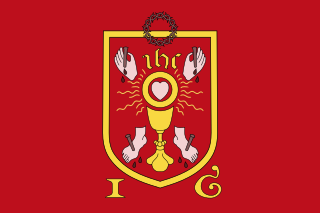
The Pilgrimage of Grace was a popular revolt beginning in Yorkshire in October 1536, before spreading to other parts of Northern England including Cumberland, Northumberland, and north Lancashire, under the leadership of Robert Aske. The "most serious of all Tudor period rebellions", it was a protest against Henry VIII's break with the Catholic Church, the dissolution of the lesser monasteries, and the policies of the King's chief minister, Thomas Cromwell, as well as other specific political, social, and economic grievances.
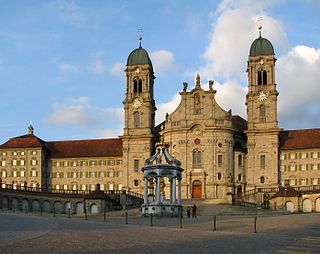
Einsiedeln Abbey is a Roman Catholic monastery administered by the Benedictine Order in the village of Einsiedeln, Switzerland. The abbey is dedicated to Our Lady of the Hermits, in recognition of Meinrad of Einsiedeln, a hermit Catholic saint. The monastery is not under the jurisdiction of a diocese or a bishop because it is a territorial abbey.
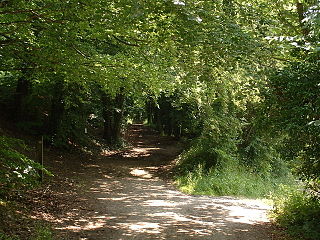
The Pilgrims' Way is the historical route supposedly taken by pilgrims from Winchester in Hampshire, England, to the shrine of Thomas Becket at Canterbury in Kent. This name, of comparatively recent coinage, is applied to a pre-existing ancient trackway dated by archaeological finds to 600–450 BC, but probably in existence since the Stone Age. The prehistoric route followed the "natural causeway" east to west on the southern slopes of the North Downs.

Rumwold was a medieval infant saint in England, said to have lived for three days in 662. He is said to have been full of Christian piety despite his young age, and able to speak from the moment of his birth, professing his faith, requesting baptism, and delivering a sermon prior to his early death. Several churches were dedicated to him, of which at least four survive.

Lorsch Abbey, otherwise the Imperial Abbey of Lorsch, is a former Imperial abbey in Lorsch, Germany, about 10 km (6.2 mi) east of Worms. It was one of the most renowned monasteries of the Carolingian Empire. Even in its ruined state, its remains are among the most important pre-Romanesque–Carolingian style buildings in Germany. Its chronicle, entered in the Lorscher Codex compiled in the 1170s, is a fundamental document for early medieval German history. Another famous document from the monastic library is the Codex Aureus of Lorsch. In 1991 the ruined abbey was listed as a UNESCO World Heritage Site because of its architectural and historical importance.
Spearhafoc was an eleventh-century Anglo-Saxon artist and Benedictine monk, whose artistic talent was apparently the cause of his rapid elevation to Abbot of Abingdon in 1047–48 and Bishop-Elect of London in 1051. After his consecration as bishop was thwarted, he vanished with the gold and jewels he had been given to make into a crown for King Edward the Confessor, and was never seen again. He was also famous for a miracle which impacted his career.

Lazarus, surnamed Zographos, is a 9th-century Byzantine Christian saint. He is also known as Lazarus the Painter and Lazarus the Iconographer. Born in Armenia on November 17, 810, he lived before and during the second period of Byzantine Iconoclasm. Lazarus was the first saint to be canonized specifically as an iconographer. He was later followed by Saint Catherine of Bologna.

The Abbey Pax Mariae, more commonly referred to as Vadstena Abbey, situated on Lake Vättern in the Diocese of Linköping, Sweden, was the motherhouse of the Bridgettine Order. The abbey started on one of the farms donated to it by the king, but the town of Vadstena grew up around it. It was active from 1346 until 1595.

Boxley Abbey in Boxley, Kent, England was a Cistercian monastery founded c.1146 by William of Ypres, leader of King Stephen's Flemish mercenaries, and colonised by monks from Clairvaux Abbey in France. Some of its ruins survive, some four miles north-east of Maidstone.
Events from the 1530s in England.

Bois-Seigneur-Isaac Abbey is a former Augustinian abbey in Wallonia, then a Premonstratensian priory, dependent on Averbode Abbey and now occupied by the Lebanese Maronite Order. It is located in Ophain-Bois-Seigneur-Isaac, Belgium.
John Hilsey was an English Dominican, prior provincial of his order, then an agent of Henry VIII and the English Reformation, and Bishop of Rochester.
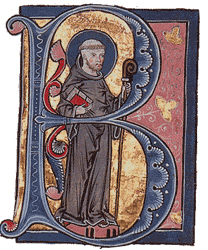
Anglican Cistercians are members of the Anglican Communion who live a common life together according to the Cistercian tradition. This tradition is usually dated to 1098 in origin. The term Cistercian is derived from Cistercium, the Latin name for the village of Cîteaux, near Dijon in eastern France. It was in this village that a group of Benedictine monks from the monastery of Molesme founded Cîteaux Abbey in 1098, with the goal of following more closely the Rule of Saint Benedict. Monks following this rule are known as Benedictine, and were at that time the dominant force in Christian monasticism. The monks of Cîteaux Abbey effectively founded a new order, but one that remains closely associated with the Benedictine Order. As a mark of their distinctive charism and rule, Cistercian monks have long worn white habits to distinguish themselves from Benedictine monks who wear black habits. Within Anglicanism there has historically been less interest in the Cistercian Order than certain other monastic Rules, although Cistercian life has been represented continuously in the Church of England since at least 1966.

St Augustine's Abbey was a Benedictine monastery in Canterbury, Kent, England. The abbey was founded in 598 and functioned as a monastery until its dissolution in 1538 during the English Reformation. After the abbey's dissolution, it underwent dismantlement until 1848. Since 1848, part of the site has been used for educational purposes and the abbey ruins have been preserved for their historical value.

















